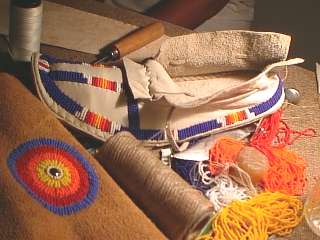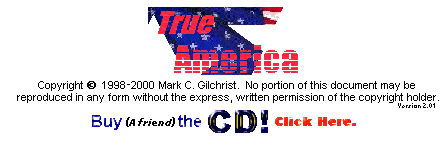Cheyenne Pride
The shoes she sews represent the epitome of simplicity, utility and strength. Made of only two pieces of leather, the moccasin is crafted the same way it has been for hundreds of years, and a good moccasin will last a hundred years. Decorated with thousands of tiny, glass beads, the shoes she sews represent beauty and tradition.
Life has changed for the Cheyenne over the past few decades. Until 1959, the Indians lived on a settlement north of town, "in tepees" someone told me (others called them shacks.) The board of health closed down the enclave and the residents moved into town. Drive through Hammon and you can see the "Indian homes." These are usually made of brick, and many line Route 34, the main road going into this agricultural town of 600 people.
The new homes were financed with help from tribal oil reserves. A visit inside one reveals a contrast between a heritage of a traditional, minimalist lifestyle, inside a modern building. Of the two Indian homes I visited, the walls were bare and the furnishings appeared to be from garage sales. (Admittedly, this is not unlike my home before I left on this trip.)
"This town is polarized," says Joe Osage, Kind Woman's father, and minister of the Indian Baptist Church. There is also a "white man" Baptist Church in town, which is much larger than the Indian one. Though the Indians have lived with the white man for four decades - there are roughly the same numbers of each race here - the two groups evidently have not mixed very well.
The dispersal of Indians from their settlement into town residences has undoubtably diluted the traditions and rituals of Cheyenne life. "There's hardly anyone who does beadwork anymore," says Kind Woman. Beading and sewing moccasins was once a necessity of life, and everyone worked at it. Today, moccasins have been replaced by sneakers and boots, Cheyennes are moving away from town and their families for work, they are marrying out of the tribe, and many of the rituals are giving way to MTV. One of the stronger traditions in Cheyenne life today is Tuesday night bingo.
Kind Woman, whose English name is now Marilyn Martinez, married a Mexican man - Jose Martinez - making her the end of the trail for her full-blooded Cheyenne heritage. "Her grandmother wanted to have me arrested," says Jose. Pure Cheyenne blood is getting very rare and it must have taken a bond of great love for Marilyn - honored by the tribe with the esteemed title of Cheyenne Princess - to marry Jose and have three children of mixed blood.
Kind Woman's mother, Cynthia Osage, (her Native name does not translate well, says Marilyn) learned the craft from her aunt, who was a Cheyenne Princess, and her mother, Maude White Skunk. Cynthia has made red beaded moccasins for Whoopi Goldberg, and pure white ones for Lionel Hampton, who gave them to his housekeeper, she says.
Many of the Osages still bead and sew moccasins, mostly as a traditional hobby. They make garments for themselves and for other Indians for Cheyenne celebrations, and they sell some, usually to tourists.
An average pair of fully beaded Cheyenne moccasins will fetch between two and three hundred dollars, but the craftsman gets much less than that. The market still works with middlemen, usually white, who own trading posts along the tourist routes. Indians will approach the store owner with their crafts and hope for the best. Some owners treat them fairly, some do not. "That man in Elk City is rude," says Kind Woman of a store owner. But she doesn't know where else to market her work.
Kind Woman is uncertain of her future. Maybe she will continue with her nursing education - a formidable option with three growing boys. "I cook for some elderly Indian people here - they charge them too much in town," she says. "Maybe I will do more of that."
Martinez would love to continue with her craft, carrying on the Cheyenne tradition. "I want to open a curio shop and sell some of my work there," she says. It is evident that Martinez enjoys helping and caring for people, but she has a love for the Cheyenne tradition of beading and sewing. There is a pride that runs very deep within this Cheyenne Princess.
Return to our MAIN page
|




 Kind Woman also makes beaded baby cribs, leggings, pipe bags and jewelry. She made moccasins for Johnny Cash when she was eleven. "He said he wanted the youngest beader in the tribe to make them for him," she says. (they were gold, by the way.) She has made a pair for the actor Judge Reinhold - they were black. (Go figure.)
Kind Woman also makes beaded baby cribs, leggings, pipe bags and jewelry. She made moccasins for Johnny Cash when she was eleven. "He said he wanted the youngest beader in the tribe to make them for him," she says. (they were gold, by the way.) She has made a pair for the actor Judge Reinhold - they were black. (Go figure.)
